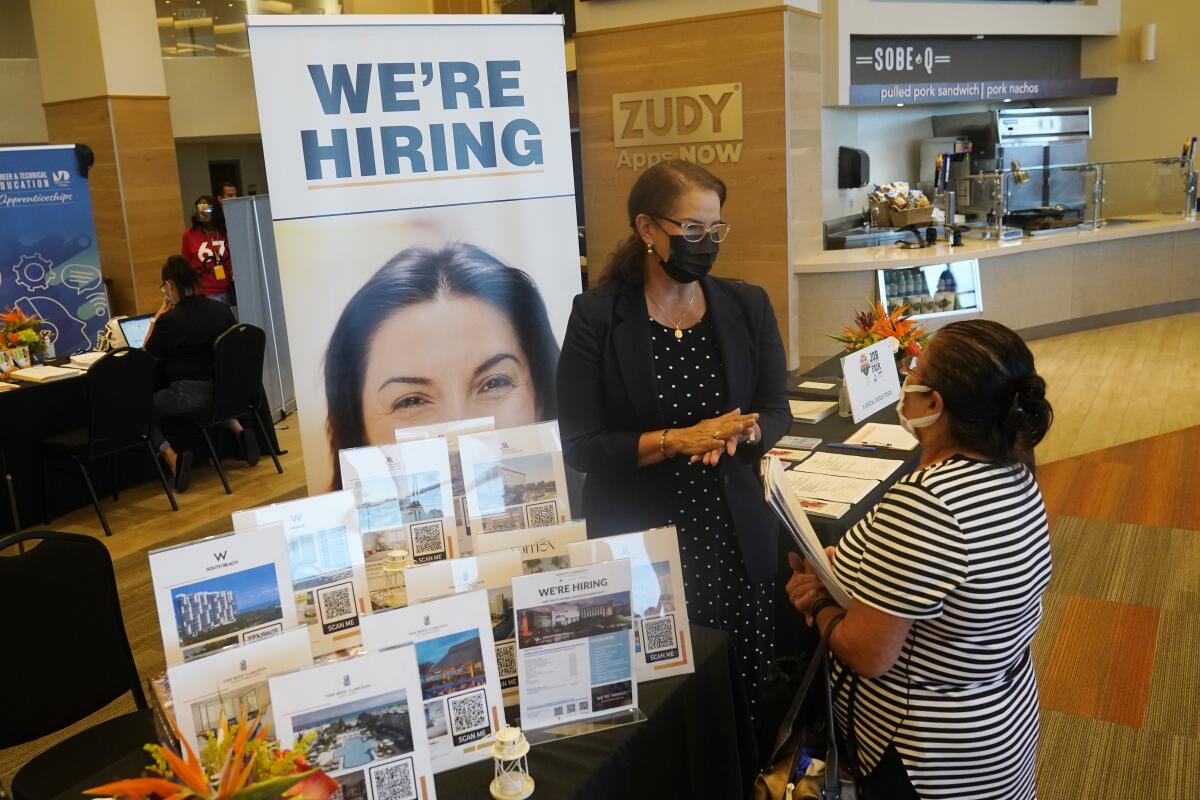A likely poor jobs figure for January could prove temporary

- Share via
WASHINGTON — Last month, U.S. employers might have shed jobs for the first time in about a year, potentially raising alarms about the economy’s trajectory.
Yet even if the January employment report coming Friday were to show a deep loss of jobs, there would be little mystery about the likely culprit: a wave of Omicron cases last month that led millions of workers to stay home sick, discouraged consumers from venturing out to spend and probably froze hiring at many companies — even those that want to fill jobs.
The number of reported Omicron infections peaked at more than 800,000 a day during the second week of January — precisely the period when the government measured employment for the month. A dismal jobs report would be a stark reminder that nearly two years after it began, the COVID-19 pandemic retains a tight grip on the economy.
Still, most economists expect a relatively quick rebound in hiring, possibly as soon as this month. Nationally, reported Omicron cases are tumbling. And many businesses are still desperate to hire: The number of job openings in late December reached nearly 11 million, just below a record set in July.
“Investors, policymakers and firm managers should essentially just write off the [January jobs] report as a one-time set of noise that will not alter the underlying strong trend in hiring and the tight labor market,” said Joe Brusuelas, chief economist at RSM, a tax advisory firm.
Economists have collectively forecast that the government will report a slight gain of 175,000 jobs for January. But some analysts, including those at Goldman Sachs, Oxford Economics and PNC Financial, have said they expect the report to show a loss of as many as several hundred thousand positions.
Last month, a survey by the Census Bureau found that nearly 8.8 million people didn’t work in early January because they were either sick with COVID-19 or had to care for someone who was. That was more than triple the corresponding number in early December. A majority of those workers probably benefit from employer-paid sick leave, and their staying home would not have affected the job count.
Employers in California and the U.S. are scrambling to fill jobs as the dust from the pandemic begins to settle. Just don’t call it a labor shortage.
But about one-fifth of workers — particularly lower-paid service employees, who are most likely to contract the virus — have no paid leave. If they missed a full pay period for sickness, their jobs would be counted as lost for the month, even though they were still employed. That would shrink the government’s job count for January.
The Labor Department uses a different method to calculate the monthly unemployment rate. With this method, even workers who were home sick during last month would be counted as employed if they had a job to return to.
The differences in the ways the numbers are calculated account for why even economists who expect a large job loss for January also expect the unemployment rate to stay at 3.9% or perhaps even decline slightly.
Worries about the January employment picture intensified Wednesday after the payroll provider ADP issued its own monthly jobs data, which, unlike the government’s official report, includes only private employers. ADP’s report calculated that companies cut 301,000 jobs in January — the worst monthly loss since the depths of the pandemic recession in April 2020. ADP’s data frequently diverge from the government’s official job count on a month-to-month basis, although ADP aims to track the federal data over time.
Nela Richardson, ADP’s chief economist, suggested that the job cuts were a direct consequence of Omicron. On a category basis, the steepest losses in ADP’s survey were at restaurants, bars, hotels and other public-facing establishments, which probably laid off some workers temporarily in response to a decline in customers. Richardson noted that in early January, she herself couldn’t schedule an appointment with a veterinarian or visit a state Department of Motor Vehicles office. Both were closed because of staffing shortages.
Many companies, she said, probably also delayed hiring plans last month. ADP’s surveys of its small and mid-size companies show that the number of companies that are seeking to add workers remains elevated, a sign that hiring probably will rebound.
“There is good evidence that suggests January is a speed bump, not a road block, on the way to recovery,” Richardson said.
Previous waves of the pandemic have also caused temporary job losses. In December 2020, the economy lost 306,000 jobs, according to the government’s tally, in the midst of a winter surge of infections before vaccines were developed.
Winter storms may also have slowed the economy and hiring last month, according to a report by UKG, which provides scheduling and other staffing software to companies. UKG said the number of shifts worked among its 35,000 business customers fell 5.1% in January, much steeper than the 3% drop that occurred in January 2021.
But the decline in shifts worked slowed at the end of the month as weather improved in most of the country and coronavirus infections began to wane.
“While the impact resulted in the largest decline in workforce activity we’ve seen since the pandemic began, this impact is expected to be temporary,” said Dave Gilbertson, vice president of UKG.
More to Read
Inside the business of entertainment
The Wide Shot brings you news, analysis and insights on everything from streaming wars to production — and what it all means for the future.
You may occasionally receive promotional content from the Los Angeles Times.











